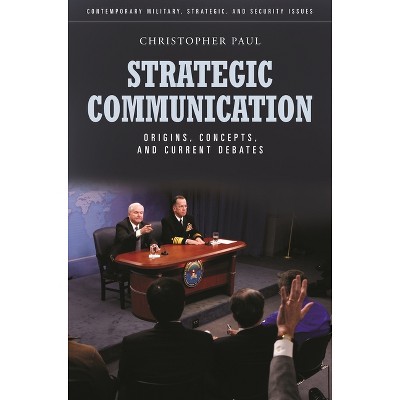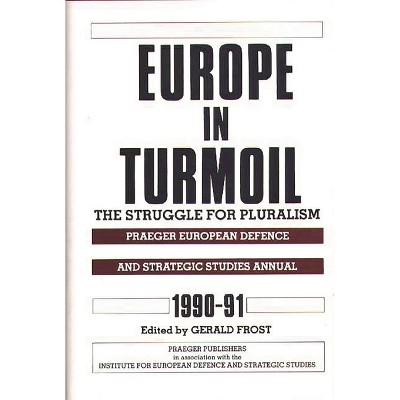Sponsored

China's Strategic Demographic Initiative - by H Yuan Tien (Hardcover)
In Stock
Sponsored
About this item
Highlights
- What has been the effect of China's focus on minimal reproduction as the centerpiece of the country's effort to regulate population growth?
- About the Author: H. YUAN TIEN is Professor of Sociology at Ohio State University and Advisor to the China Population and Research Center in Beijing.
- 334 Pages
- Social Science, Demography
Description
About the Book
What has been the effect of China's focus on minimal reproduction as the centerpiece of the country's effort to regulate population growth? This book tells the full story of China's Strategic Demographic Initiative, tracing its evolutions and assessing its results and significance in the context of China's socioeconomic development. Early consensus in population planning gave rise to voluminous rules, massive drives, vigorous exhortations, varied sanctions, and above all, strict enforcement. The one child per couple policy begun in 1978-79 stirred up strong emotional debate both within China and throughout the outside world. This text demonstrates the approach, scope, and tempo of China's population planning.
China's Strategic Demographic Initiative is presented in three parts. First, the overall circumstances which helped to shape China's population planning effort are revealed. Next the startup, evolutions, and objectives of the Strategic Demographic Initiative are interwoven with objections and obstacles to implementation. Finally, the issue of collective intervention in childbearing and the limits to population planning bring in social and economic issues. Major lessons are reviewed. An epilogue updates the direction of China's population planning effort amid continuing internal dispute over tactics.
Book Synopsis
What has been the effect of China's focus on minimal reproduction as the centerpiece of the country's effort to regulate population growth? This book tells the full story of China's Strategic Demographic Initiative, tracing its evolutions and assessing its results and significance in the context of China's socioeconomic development. Early consensus in population planning gave rise to voluminous rules, massive drives, vigorous exhortations, varied sanctions, and above all, strict enforcement. The one child per couple policy begun in 1978-79 stirred up strong emotional debate both within China and throughout the outside world. This text demonstrates the approach, scope, and tempo of China's population planning.
China's Strategic Demographic Initiative is presented in three parts. First, the overall circumstances which helped to shape China's population planning effort are revealed. Next the startup, evolutions, and objectives of the Strategic Demographic Initiative are interwoven with objections and obstacles to implementation. Finally, the issue of collective intervention in childbearing and the limits to population planning bring in social and economic issues. Major lessons are reviewed. An epilogue updates the direction of China's population planning effort amid continuing internal dispute over tactics.Review Quotes
?Anyone wishing to understand China's population planning policies since 1970 should read this book. Tien (Ohio State University) is one of the leading specialists in Chinese demography. In this sequel to his China's Population Struggle (1973) Tien traces the changes and reversals in Chinese population policy over the last 20 years. This policy, China's "strategic demographic initiative," was the most extensive demographic project in world history. Tien uses recent data from China to assess the goals, tactics, and impact of China's comprehensive planning effort. He examines the genesis and outcome of the "one child" policy and suggests this policy has been largely successful. This well-written, solid, scholarly treatment of an important demographic topic includes much useful data as well as an excellent bibliography. Upper-division undergraduates and above.?-Choice
?Though filled with demographically rich data, the book is clear and easily absorbed by the non-specialist." Asian-Pacific Economic Literature "Indeed, the unique contribution of the book is its discussion of the debates in China in the late 1970s and in the last four years about what direction fertility policy should take.?-Pacific Affairs
"Though filled with demographically rich data, the book is clear and easily absorbed by the non-specialist." Asian-Pacific Economic Literature "Indeed, the unique contribution of the book is its discussion of the debates in China in the late 1970s and in the last four years about what direction fertility policy should take."-Pacific Affairs
"Anyone wishing to understand China's population planning policies since 1970 should read this book. Tien (Ohio State University) is one of the leading specialists in Chinese demography. In this sequel to his China's Population Struggle (1973) Tien traces the changes and reversals in Chinese population policy over the last 20 years. This policy, China's "strategic demographic initiative," was the most extensive demographic project in world history. Tien uses recent data from China to assess the goals, tactics, and impact of China's comprehensive planning effort. He examines the genesis and outcome of the "one child" policy and suggests this policy has been largely successful. This well-written, solid, scholarly treatment of an important demographic topic includes much useful data as well as an excellent bibliography. Upper-division undergraduates and above."-Choice
About the Author
H. YUAN TIEN is Professor of Sociology at Ohio State University and Advisor to the China Population and Research Center in Beijing. He is the author of several books in Chinese and English on demography, and has written numerous articles for Population Today, Social Science Quarterly, and Modern China, among others.










